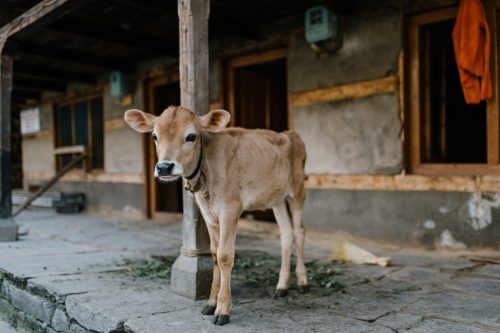
Cattle ranching is one of the most widespread uses of land in the world today. Cows are raised on all continents and in various climates, from frigid Siberian steppes to sunny pastures of California. The size of land you need for cattle ranching depends on how many heads of cattle you want to raise, what types of feed they will be eating, and how much space you intend to leave between each animal. If you are considering cattle ranching, ask yourself the following:
How Many Heads Of Cattle?
To estimate how much land you need for a ranch, you have to know how many heads of animals the ranch will hold. The United States has several popular breeds: Angus, Brangus, Hereford, and Shorthorn are some of the most common types in ranches.
If you intend to raise these or another breed of cow, your livestock will eat around 15 pounds of plant-based feed daily, including grass hay, legumes, or silage per 1000 pounds body weight. This means that an average 1,400-pound cow will require about 19 pounds of food every day. If you allow 100 square feet per animal, that will add up to around 3 acres per cow.
What Types Of Feeds?
Cows that are raised to produce beef do not require the same amount of land as dairy cows. Beef cattle require about 10-15% more space to supply the same nutritional needs, but this can vary depending on breed and other factors. A 1,400-pound cow will eat around 19 pounds of plant-based feed daily grass hay, legumes, or silage, while a 1,200-pound cow will only eat around 17 pounds per day, and a 500-pound calf will need 4 pounds daily.
If you want 100 square feet per animal, that will add up to 2.25 acres for each beef cow and 1 acre for every tenth cow in your herd if you have a dairy cow.
The average dairy cow produces about 8,000 pounds of milk each year. The same space requirements apply for mother and calf: 100 square feet per animal, which adds up to around 3 acres if you have a herd of dairy cattle.
This makes it possible to raise around six beef cows or 40 dairy cows on one acre, depending on breed and grazing conditions. This is a very general estimate since land quality can vary greatly within the continental United States alone.
Type of the Animals
Some types of cattle can be raised in relatively small spaces, but the land must still be used carefully. Miniature cattle breeds are about one-quarter to one-fifth the size of full-sized breeds and require two acres per head instead of five or ten for normal cows.
A full-sized cow’s footprint is also proportionally larger than a miniature cow. This makes more space necessary within a confined area where you intend to raise both types of cattle, which will increase your total land requirements by up to 2 times when it comes time to rotate pastures and graze on various plots.
Space Between Animals
Space requirements also vary depending on how many animals you intend to graze per acre. If you want one animal per acre, that means they will each need 100 square feet of space, or 5,000 square feet total if you have a herd of beef cattle. This adds up to 10 acres for every five heads of animals you raise, 20 acres for ten cows, and so on.
In organic and free-range ranches, animals are typically given access to a wide range instead of being confined to individual pastures. This works because animals eat for most of the day regardless of where they live or eat: one acre per animal will be fine if you give them room to roam in herds rather than confining them in small spaces. In other words, animals should have their area to sleep and rest and need enough space during the day to graze and still have room to move around.
Basic Rule In Spacing Animals
A simple rule is that there should be at least 10 feet between each animal when it comes time for feeding or 15 feet apart if the pasture is particularly dry. That means you should have at least 10 feet between a 1,400-pound animal and every other one if you want one animal per acre. With more space between them, there will be plenty of room to graze without interfering with the animals around them. Getting the right calving pen alberta equipment is crucial for ranchers to ensure the safety and well-being of their cattle during calving season.
The amount of land required to raise your herd depends on the size, what type of feed you’re giving them, the type of animals and how many animals you plan to graze per acre.
Interesting Related Article: “Mouse gene may protect cattle from bovine TB“

